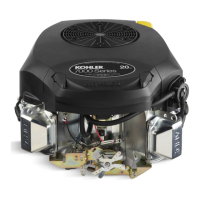Fuel System
32 32 690 03 Rev. IKohlerEngines.com
Troubleshooting-Carburetor Related Causes
Condition Possible Cause Conclusion
Engine runs rich (indicated by black,
sooty exhaust smoke, misfi ring, loss
of speed and power, governor
hunting, or excessive throttle
opening).
Clogged air cleaner. Clean or replace air cleaner.
Choke partially closed during
operation.
Check choke lever/linkage to ensure
choke is operating properly.
Float level is set too high. Adjust fl oat (Keihin only, Walbro not
adjustable).
Dirt under fuel inlet needle. Remove needle; clean needle and
seat and blow with compressed air.
Bowl vent or air bleeds plugged. Clean vent, ports, and air bleeds.
Blow out all passages with
compressed air.
Leaky, cracked, or damaged fl oat. Submerge fl oat to check for leaks.
Engine runs lean (indicated by
misfi ring, loss of speed and power,
governor hunting, or excessive
throttle opening).
Float level is set too low. Adjust fl oat (Keihin only, Walbro not
adjustable).
Idle holes plugged; dirt in fuel delivery
channels.
Clean main fuel jet and all passages;
blow out with compressed air.
Fuel leaks from carburetor. Float level set too high. Adjust fl oat (Keihin only, Walbro not
adjustable).
Dirt under fuel inlet needle. Remove needle; clean needle and
seat and blow with compressed air.
Bowl vents plugged. Blow out with compressed air.
Carburetor bowl gasket leaks. Replace gasket.
FUEL SYSTEM
Fuel Shut-off Solenoid
Most carburetors are equipped with a fuel shut-off
solenoid. Solenoid is attached to fuel bowl. Solenoid has
a spring-loaded pin that retracts when 12 volts is applied
to lead, allowing fuel fl ow to main jet. When current is
removed, pin extends blocking fuel fl ow.
Below is a simple test, performed with engine off, that
can determine if solenoid is functioning properly:
1. Shut off fuel and remove solenoid from carburetor.
When solenoid is loosened and removed, gas will
leak out of carburetor. Have a container ready to
catch fuel.
2. Wipe tip of solenoid with a shop towel or blow with
compressed air to remove any remaining fuel. Take
solenoid to a location with good ventilation and no
fuel vapors present. You will also need a 12 volt
power source that can be switched on and off.
3. Be sure power source is switched OFF. Connect
positive power source lead to red lead of solenoid.
Connect negative power source lead to solenoid
body.
4. Turn power source ON and observe pin in center of
solenoid. Pin should retract with power ON and
return to its original position with power OFF. Test
several times to verify operation.
Carburetor Circuits
Float
Fuel level in bowl is maintained by fl oat and fuel inlet
needle. Buoyant force of fl oat stops fuel fl ow when
engine is at rest. When fuel is being consumed, fl oat will
drop and fuel pressure will push inlet needle away from
seat, allowing more fuel to enter bowl. When demand
ceases, buoyant force of fl oat will again overcome fuel
pressure, rising to predetermined setting and stop fl ow.
Slow and Mid-Range
At low speeds engine operates only on slow circuit. As
a metered amount of air is drawn through slow air bleed
jets, fuel is drawn through main jet and further metered
through slow jet. Air and fuel are mixed in body of slow
jet and exit to idle progression (transfer port) chamber.
From idle progression chamber, air fuel mixture is
metered through idle port passage. At low idle air/fuel
mixture is controlled by setting of idle fuel adjusting
screws. This mixture is then mixed with main body of
air and delivered to engine. As throttle plate opening
increases, greater amounts of air/fuel mixture are drawn
in through fi xed and metered idle progression holes.
As throttle plate opens further, vacuum signal becomes
great enough at venturi so main circuit begins to work.
Main (high-speed)
At high speeds/loads engine operates on main circuit.
As a metered amount of air is drawn through air jet,
fuel is drawn through main jet. Air and fuel are mixed
in main nozzles then enters main body of airfl ow where
further mixing of fuel and air occurs. This mixture is then
delivered to combustion chamber. Carburetor has a fi xed
main circuit; no adjustment is possible.

